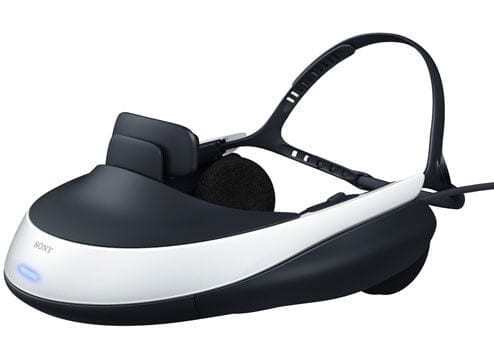Two of Opace’s finest, Rob Bryan and Adam Bullas, have a huge interest in the virtual reality space and have experimented with the Oculus Rift, HTC Vive, Samsung Gear VR, PlayStation VR and the Google Cardboard. Rob, as the Technical Director, and Adam as the Marketing Manager, are both interested in web development as well as open source technology, so the later releases of the virtual reality technology, such as the Oculus Rift Development Kit (DK2), were perfect for them as they were able to test the tech and see where it was going.
This interview is part of our series of articles below on “VR for business”:
- The History, Rise & Fall of Virtual Reality
- Has Oculus Lost the First Generation of Virtual Reality to HTC
- How Marketers Can Use Virtual Reality
- Virtual Reality vs. Augmented Reality & the Applications for Business
- Open Source Virtual Reality and What This Means for Business
- Virtual Reality Web Design; Why Every Business Will Need to Factor VR into Their Digital Marketing
- Virtual Reality eCommerce & the Future of Online Shopping (vCommerce)
- The Lowdown from Our VR Gurus, Rob and Adam
We would love to encourage some discussion and debate around where this interesting and game-changing technology is heading, so please feel free to leave us a comment below or on social media and we’ll get back to you. So, let’s get on to the interview..
Who’s winning the virtual reality race, why, and what’s next for VR technology?
-
1
Who’s winning the virtual reality race, why, and what’s next for VR technology?
- 1.1 Q. Why do you think that virtual reality has noticed such a boom recently?
- 1.2 Q. Who do you think is winning the virtual reality race?
- 1.3 Q. What sets the HTC Vive apart from the others?
- 1.4 Q. What do you think consumers are looking for most from a virtual reality headset?
- 1.5 Q. Where do you think virtual reality will have the biggest impact aside from gaming?
- 1.6 Q. Where do you see the future of virtual reality heading?
- 1.7 Q. Is there anything virtual reality companies aren’t currently doing that they could do better?
- 1.8 Q. We recently read a study that said that by 2040 we could have full-sensory virtual reality. How likely do you think this is?
- 1.9 Q. How can you see Opace and virtual reality working together?
- 1.10 Q. Do you plan on working virtual reality web design in as part of the Opace package?
- 1.11 Q. Any other thoughts?
We picked their virtual reality brains for the lowdown on who’s winning the virtual reality race, why, and what’s next for the technology as well as how virtual reality and Opace could work hand-in-hand.
Q. Why do you think that virtual reality has noticed such a boom recently?
 Rob: Virtual reality has been around for a while, I remember seeing a futuristic looking virtual reality headset down on Blackpool pier in the late 90s, it wasn’t very good as you can imagine, but it definitely got my imagination going about what the future might hold for virtual reality. You even had the Sony HMZ1 back in 2000, but it had a low refresh rate, low screen resolution and it cost thousands of dollars, which was far too much for such an inferior experience; the tech just wasn’t where it needed to be yet.
Rob: Virtual reality has been around for a while, I remember seeing a futuristic looking virtual reality headset down on Blackpool pier in the late 90s, it wasn’t very good as you can imagine, but it definitely got my imagination going about what the future might hold for virtual reality. You even had the Sony HMZ1 back in 2000, but it had a low refresh rate, low screen resolution and it cost thousands of dollars, which was far too much for such an inferior experience; the tech just wasn’t where it needed to be yet.

Sony HMZ – credit: Sony
Now they’re all a much more reasonable price, and the technology is much more advanced. The software and the hardware of virtual reality are dependent on each other, and until now one of the two has been behind the other in certain areas. The concept and thought behind virtual reality have moved on as well; it’s no longer a gimmick but now a viable device for entertainment.
 Adam: There’s also a misconception that the price of virtual reality headsets are only for some people; the Oculus Rift and the HTC Vive, which are the most expensive, are only for the best of the best experiences, but people can still have experiences without needing to spend lots of money. For example, you can buy the Google Cardboard for $15, and anyone that has a smartphone can use it as an attachment to experience virtual reality.
Adam: There’s also a misconception that the price of virtual reality headsets are only for some people; the Oculus Rift and the HTC Vive, which are the most expensive, are only for the best of the best experiences, but people can still have experiences without needing to spend lots of money. For example, you can buy the Google Cardboard for $15, and anyone that has a smartphone can use it as an attachment to experience virtual reality.
These different levels of headsets make virtual reality much more accessible to the wider public as a whole. We’ve got the entry level with Google Cardboard, the next level up with Samsung Gear VR, which are around £70, and then the higher level with the HTC Vive and Oculus Rift.
Q. Who do you think is winning the virtual reality race?
 Rob: For me the HTC Vive has blown all other competition out of the water as it’s truly immersive. We’re at a contentious point at the moment because it seems like Oculus have lost this generation of virtual reality as they haven’t kept up with HTC.
Rob: For me the HTC Vive has blown all other competition out of the water as it’s truly immersive. We’re at a contentious point at the moment because it seems like Oculus have lost this generation of virtual reality as they haven’t kept up with HTC.
 Adam: The Oculus product launch has been awful, they were complacent as they had no competition and planned to stagger the tech overtime but then HTC came out of nowhere with all of the tech. The Vive has better technology and they definitely have the upper hand at the moment, but it’s only as good as the developers that are developing it. However, they’ve partnered with Steam & Valve, and Valve is huge, so there’s a lot of hype there.
Adam: The Oculus product launch has been awful, they were complacent as they had no competition and planned to stagger the tech overtime but then HTC came out of nowhere with all of the tech. The Vive has better technology and they definitely have the upper hand at the moment, but it’s only as good as the developers that are developing it. However, they’ve partnered with Steam & Valve, and Valve is huge, so there’s a lot of hype there.
 Rob: To be honest the Vive wouldn’t even exist if Facebook hadn’t bought Oculus, so Oculus did kickstart the virtual reality race, but they’re falling behind now. Oculus and HTC both seem like they’re going down the exclusive route though which is a shame.
Rob: To be honest the Vive wouldn’t even exist if Facebook hadn’t bought Oculus, so Oculus did kickstart the virtual reality race, but they’re falling behind now. Oculus and HTC both seem like they’re going down the exclusive route though which is a shame.
Q. What sets the HTC Vive apart from the others?
 Rob: It’s all because of the technology. Aesthetically, the Oculus beats the Vive hands down – you can see the love and care that’s gone into it there. But as soon as my Vive arrived I thought I might as well just sell my Oculus as the Vive’s tech is so much better and the experience is just so much more engaging with room-scale, tracked controllers. It blew my mind!
Rob: It’s all because of the technology. Aesthetically, the Oculus beats the Vive hands down – you can see the love and care that’s gone into it there. But as soon as my Vive arrived I thought I might as well just sell my Oculus as the Vive’s tech is so much better and the experience is just so much more engaging with room-scale, tracked controllers. It blew my mind!
Q. What do you think consumers are looking for most from a virtual reality headset?
 Adam: It completely depends on the consumer as the average gamer is different to the average consumer. There could be a big demand for mini games for companies, such as a Topman mini game in a virtual reality setting.
Adam: It completely depends on the consumer as the average gamer is different to the average consumer. There could be a big demand for mini games for companies, such as a Topman mini game in a virtual reality setting.
 Rob: For me, I want to forget where I am. Not necessarily with gameplay, but I just want to be transported somewhere. There’s already so many uses for this tech; it doesn’t even feel like you have a screen in front of you. There’s a misconception for those that haven’t tried it that it feels clunky, and you can see the screen in front of you, but the sense of depth and scale is what shocked me, it feels like you’re in this new world.
Rob: For me, I want to forget where I am. Not necessarily with gameplay, but I just want to be transported somewhere. There’s already so many uses for this tech; it doesn’t even feel like you have a screen in front of you. There’s a misconception for those that haven’t tried it that it feels clunky, and you can see the screen in front of you, but the sense of depth and scale is what shocked me, it feels like you’re in this new world.
Q. Where do you think virtual reality will have the biggest impact aside from gaming?
 Adam: I think that cinema is going to be a big one, but more just media consumption as a whole, for example with something like Netflix. There will be little need for a screen at home, and you don’t need to pay thousands of pounds for a big screen anymore; you can have a huge cinema experience from your bedroom. Previously, your monitor was a window to the world, but virtual reality is like 2.0.
Adam: I think that cinema is going to be a big one, but more just media consumption as a whole, for example with something like Netflix. There will be little need for a screen at home, and you don’t need to pay thousands of pounds for a big screen anymore; you can have a huge cinema experience from your bedroom. Previously, your monitor was a window to the world, but virtual reality is like 2.0.
 Rob: Cinema and shopping definitely. You’ve got Amazon at the moment, so a lot of people don’t go onto the high street anymore as we want things to be convenient, but a retail experience from a shop with the simplicity of something like Amazon from your living room could be amazing.
Rob: Cinema and shopping definitely. You’ve got Amazon at the moment, so a lot of people don’t go onto the high street anymore as we want things to be convenient, but a retail experience from a shop with the simplicity of something like Amazon from your living room could be amazing.
 Adam: This is where PlayStation might push things forward. They previously had PlayStation Home on the PS3, and it’s interesting to think where they could go with this. You could download an app for Playstation, maybe an Amazone, that has a virtual reality option with it.
Adam: This is where PlayStation might push things forward. They previously had PlayStation Home on the PS3, and it’s interesting to think where they could go with this. You could download an app for Playstation, maybe an Amazone, that has a virtual reality option with it.
Q. Where do you see the future of virtual reality heading?
R&A: eCommerce will be a big one, for example, you could transform your room into a store. It’s inevitable that retail will go this way as well, especially as Tesco and IKEA have already tried it. It’ll also be great for relaxation or exploration; you could go and chill in the Caribbean or explore Aztec ruins.

Tesco’s virtual reality. Credit: FIGUREdigital
We think sports will utilise virtual reality as well, like selling virtual tickets with 360-degree views. It’s a great appeal to people that can’t make it to the match themselves for whatever reason.
 Rob: Virtual reality could change almost everything, it just takes someone like Palmer Luckey (Founder of Oculus) to grasp it, and you just need someone to try it first to set the change in motion. It’s like that famous quote from Henry Ford that goes something like a hundred years ago if you’d asked people what kind of transport they wanted they would have said a faster horse. You need to show people what they want before they know that they want it.
Rob: Virtual reality could change almost everything, it just takes someone like Palmer Luckey (Founder of Oculus) to grasp it, and you just need someone to try it first to set the change in motion. It’s like that famous quote from Henry Ford that goes something like a hundred years ago if you’d asked people what kind of transport they wanted they would have said a faster horse. You need to show people what they want before they know that they want it.
 Adam: It’s definitely going to have as big an impact on society as the smartphone has.
Adam: It’s definitely going to have as big an impact on society as the smartphone has.
Q. Is there anything virtual reality companies aren’t currently doing that they could do better?
 Rob: Valve & HTC have the right approach as you can use any virtual reality enabled stuff on steam with any virtual reality headset. Plus there’s OSVR (open source virtual reality) and then OpenVR, which is made by Valve and supports all headsets. But at the moment, if Adam has an Oculus Rift and I have the HTC Vive, and we can’t interact in the same experiences, then what’s the point?
Rob: Valve & HTC have the right approach as you can use any virtual reality enabled stuff on steam with any virtual reality headset. Plus there’s OSVR (open source virtual reality) and then OpenVR, which is made by Valve and supports all headsets. But at the moment, if Adam has an Oculus Rift and I have the HTC Vive, and we can’t interact in the same experiences, then what’s the point?
Oculus are like a walled garden and want to be exclusive. They’re like the Apple of the virtual reality world. On their curated store, they will reject any experience that can’t meet a steady 75fps+ and want only the highest quality, which is great, but is limiting the sorts of things we can experience. Luckey says that they do support outside technology, but not actively. It’s like one foot in one foot out, whereas the Vive seems more inclusive.
 Adam: Why haven’t Valve produced a game that has utilised the virtual reality situation yet? They will at some point obviously, but this should have been done at launch. Valve could have capitalised on this opportunity while Oculus haven’t.
Adam: Why haven’t Valve produced a game that has utilised the virtual reality situation yet? They will at some point obviously, but this should have been done at launch. Valve could have capitalised on this opportunity while Oculus haven’t.
Q. We recently read a study that said that by 2040 we could have full-sensory virtual reality. How likely do you think this is?
 Adam: This is definitely likely and not far-fetched at all. It won’t be long before artificial limbs exceed default body limbs. Think of Moore’s Law – the rate at which tech increases is getting faster and faster.
Adam: This is definitely likely and not far-fetched at all. It won’t be long before artificial limbs exceed default body limbs. Think of Moore’s Law – the rate at which tech increases is getting faster and faster.
 Rob: I think it will happen faster. There will be more devs and more programmers working on it as it gets more popular. The Vive has only been out one month and while the tracked controllers are absolutely fantastic; the tech is already moving on beyond this with things like the Leap Motion controllers, allowing your actual hands and fingers to be tracked and visible in the virtual reality space.
Rob: I think it will happen faster. There will be more devs and more programmers working on it as it gets more popular. The Vive has only been out one month and while the tracked controllers are absolutely fantastic; the tech is already moving on beyond this with things like the Leap Motion controllers, allowing your actual hands and fingers to be tracked and visible in the virtual reality space.
Q. How can you see Opace and virtual reality working together?
 Rob: eCommerce will be a big one – having your room transformed into a store where you can get close to products. We want to be on the bleeding edge – the last example is with responsive web design in 2011. Prior to this you had two separate versions for mobile and desktop, which we tried to get on quickly at Opace. Now it’s the norm. If virtual reality is going to become big in the space, it would be good for us to jump on it now, while it’s still fresh.
Rob: eCommerce will be a big one – having your room transformed into a store where you can get close to products. We want to be on the bleeding edge – the last example is with responsive web design in 2011. Prior to this you had two separate versions for mobile and desktop, which we tried to get on quickly at Opace. Now it’s the norm. If virtual reality is going to become big in the space, it would be good for us to jump on it now, while it’s still fresh.
 Adam: Opace could offer a product to sell to eCommerce businesses for a virtual environment, but we’re still a way off from this. It depends on how people like Amazon embrace it.
Adam: Opace could offer a product to sell to eCommerce businesses for a virtual environment, but we’re still a way off from this. It depends on how people like Amazon embrace it.
 Rob: My one concern is that there is no one ideal platform for giving a customer a virtual reality experience that incorporates the web as we know it and until that happens it’s difficult to offer solutions. People haven’t considered the possibilities of eCommerce and web design in virtual reality yet.
Rob: My one concern is that there is no one ideal platform for giving a customer a virtual reality experience that incorporates the web as we know it and until that happens it’s difficult to offer solutions. People haven’t considered the possibilities of eCommerce and web design in virtual reality yet.
 Adam: It requires someone to have forward thinking with this and as we said earlier it’s about knowing what consumers want before they do.
Adam: It requires someone to have forward thinking with this and as we said earlier it’s about knowing what consumers want before they do.
Q. Do you plan on working virtual reality web design in as part of the Opace package?
 Rob: Web development is my job and creating virtual reality environments is my hobby so I’d love to combine the two. I spend a lot of time working with the Unreal Engine 4, and it would be great to mix all of the tech together. But would the public be interested? This is something we need to survey.
Rob: Web development is my job and creating virtual reality environments is my hobby so I’d love to combine the two. I spend a lot of time working with the Unreal Engine 4, and it would be great to mix all of the tech together. But would the public be interested? This is something we need to survey.
 Adam: It’s difficult at the moment. If you created a virtual eCommerce site for a clothes company, you’d have to change it every time there’s a new range of clothes out. The company might not even know what they’re going to be selling – it would require constant work with the client.
Adam: It’s difficult at the moment. If you created a virtual eCommerce site for a clothes company, you’d have to change it every time there’s a new range of clothes out. The company might not even know what they’re going to be selling – it would require constant work with the client.
 Rob: Back in the 2000s there was no open source solution for web design, but now with Magento, WordPress or WooCommerce someone with no tech knowledge can do it themselves. It could take a long time, perhaps even years, but we’ll get to that same point with virtual reality.
Rob: Back in the 2000s there was no open source solution for web design, but now with Magento, WordPress or WooCommerce someone with no tech knowledge can do it themselves. It could take a long time, perhaps even years, but we’ll get to that same point with virtual reality.
 Adam: You could have a middle man company doing this that could create virtual reality settings for companies. Their job could be to keep the clothes line fresh every day/week etc. Of course, though, this would require a bit of extra cash.
Adam: You could have a middle man company doing this that could create virtual reality settings for companies. Their job could be to keep the clothes line fresh every day/week etc. Of course, though, this would require a bit of extra cash.
Q. Any other thoughts?
 Rob: Since I tried the Oculus Development Kit 1 I’ve sat back and waited for everyone else to get on board, feeling confident to myself that this technology is going to change the world once people start experiencing it. Now that the Oculus Rift CV1 and HTC Vive are out this will happen quickly. There’s a backlog of orders so there’s clearly a public interest. If one person in a friend group buys it then everyone will. It’s like playing the waiting game at the moment, but this happens with any new tech. We’re both excited to see where virtual reality takes us in the future!
Rob: Since I tried the Oculus Development Kit 1 I’ve sat back and waited for everyone else to get on board, feeling confident to myself that this technology is going to change the world once people start experiencing it. Now that the Oculus Rift CV1 and HTC Vive are out this will happen quickly. There’s a backlog of orders so there’s clearly a public interest. If one person in a friend group buys it then everyone will. It’s like playing the waiting game at the moment, but this happens with any new tech. We’re both excited to see where virtual reality takes us in the future!

![Seo content creation guide for good content - why good content matters: seo content creation guidelines [updated] Seo content creation guidelines for good content](https://www.opace.co.uk/wp-content/uploads/2024/03/SEO-content-creation-guide-for-good-content-150x150.jpeg)




0 Comments